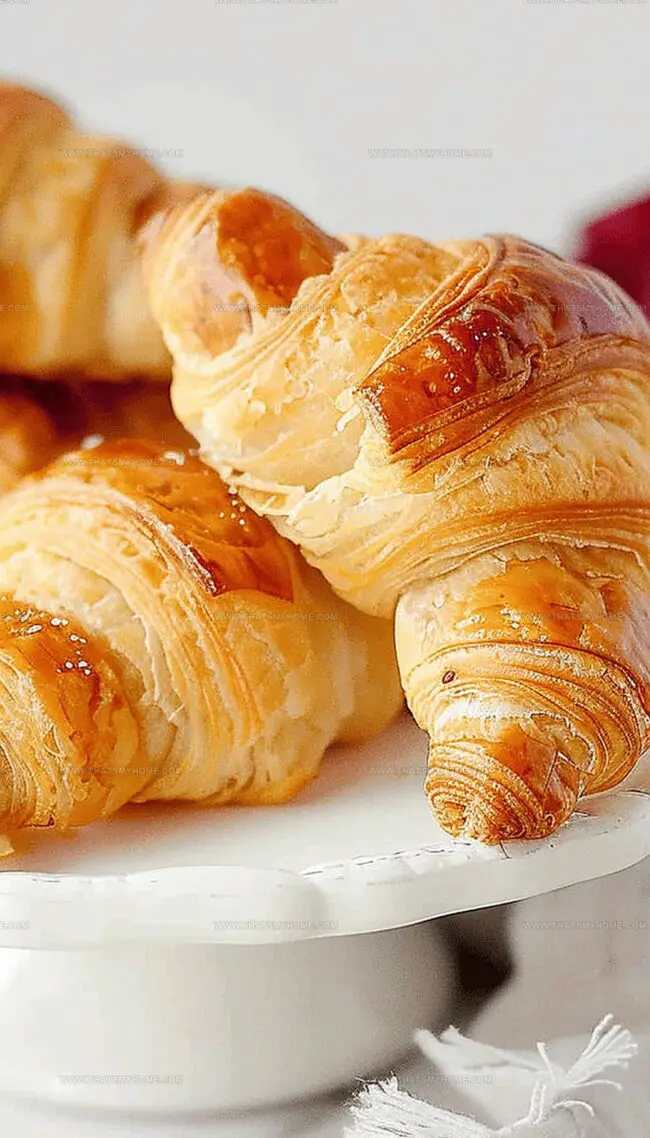Flaky & Foolproof Homemade Croissants Recipe for Beginners
Homemade croissants transport you to a world of buttery, multilayered delicacy that defies ordinary bakery expectations.
French pastry artistry demands precision and patience, reinventing simple ingredients into extraordinary culinary magic.
Delicate lamination creates those signature gossamer-thin layers that practically whisper with each tender bite.
Mastering this technique requires steady hands and a commitment to understanding dough’s intricate chemistry.
Incredible textures emerge from carefully folded butter and flour, revealing an almost sculptural approach to baking.
Professional bakers spend years perfecting these golden-brown crescents, but passionate home cooks can absolutely create restaurant-quality results.
Prepare to embark on a delightful culinary adventure that will elevate your baking skills.
Buttery Homemade Croissants You Can’t Resist
Essential Ingredients for Homemade Croissants
How to Make Flaky Homemade Croissants
Step 1: Prepare Ingredients
Remove milk and butter from refrigerator. Cut butter into tablespoon-sized cubes and set aside.
Step 2: Prepare Mixing Bowl
Spray a large mixing bowl with cooking spray to ensure easy cleanup later.
Step 3: Mix Dry Ingredients
In stand mixer bowl, combine dry ingredients:Mix these ingredients using a whisk or dough hook until well blended.
Step 4: Activate Yeast
For instant yeast: Add to opposite side of bowl away from salt and stir lightly.
For active dry yeast: Sprinkle over warm water in measuring cup and proof for 3-5 minutes until foamy.
Step 5: Create Dough Base
Pour water and milk over flour mixture. Blend at medium-high speed until smooth (8-10 minutes). Adjust by adding flour or water if dough seems too sticky or dry.
Step 6: First Dough Rest
Remove dough from mixer and shape into a ball. Place in prepared mixing bowl, cover with plastic wrap, and let rest in warm area for 30 minutes.
Step 7: Prepare Butter Mixture
Clean mixer bowl and attach paddle attachment. Mix cubed butter with flour until creamy. Avoid overmixing.
Step 8: Butter Preparation
Place butter mixture on plastic wrap, forming a 6-inch square. Wrap tightly and chill.
Step 9: First Dough Rolling
Transfer dough to floured surface. Roll into a 10-inch square, sprinkling additional flour as needed.
Step 10: First Butter Incorporation
Place chilled butter diagonally across dough center. Fold corners inward, pinching seams closed securely.
Step 11: First Chill
Place folded pastry on baking sheet, cover loosely with plastic wrap. Refrigerate for 60 minutes.
Step 12: First Folding Process
Roll chilled packet to 16×8 inches. Brush off excess flour. Fold sides toward middle like a letter. Return to refrigerator for 60 minutes. Repeat folding process twice more.
Step 13: Shape Croissant Triangles
Remove dough and slice in half. Cut each section into triangles:Trim edges to ensure neat shapes.
Step 14: Roll Croissants
Start rolling from broad base, spiraling upward toward pointed top. Maintain consistent tightness for each croissant.
Step 15: Freezing Option
Prepare for freezer storage if desired.
Step 16: Final Proof
Place croissants on lined baking sheets. Cover and let rise in warm area for 60-90 minutes until doubled in size.
Step 17: Bake to Perfection
Preheat oven:Brush with egg wash. Bake for 20 minutes, rotating pans halfway. Cool on wire rack.
Enjoy your homemade croissants!
Tips for the Best Homemade Croissants
Storing and Reheating Homemade Croissants
Pairing Homemade Croissants with Jams
Variations of Homemade Croissants
Print
Homemade Croissants Recipe
- Total Time: 1 hour 5 minutes
- Yield: 12 1x
Description
Delicate French croissants reveal buttery layers of culinary artistry, crafted with patience and precision. Golden, flaky pastries emerge from careful folding and rolling, inviting you to savor each delectable bite of authentic Parisian elegance.
Ingredients
Main Ingredients:
- 1.5 cups (340 grams) unsalted butter, cut into cubes (slightly cool)
- 3.5 cups (440 grams) all-purpose flour
- 2 tablespoons (15 grams) all-purpose flour
- 1 cup (240 milliliters) whole milk
Leavening and Flavoring:
- 2.25 teaspoons instant yeast
- 0.33 cup (70 grams) granulated sugar
- 2 teaspoons salt
Liquid Ingredients:
- 0.5 cup (120 milliliters) water, room temperature
- 1 large egg, beaten (for brushing)
Instructions
- Extract butter and milk from refrigerator. Dice butter into 1/2-inch (1.27 centimeters) cubes and set aside at room temperature.
- Sanitize a large mixing bowl with cooking spray to facilitate easy cleaning post-preparation.
- Combine flour, sugar, and salt in stand mixer’s work bowl, using a whisk to thoroughly integrate dry ingredients.
- Activate yeast by sprinkling over lukewarm water (105-110°F or 40-43°C). Allow 3-5 minutes for foaming and proofing.
- Incorporate water and milk into flour mixture. Blend at medium-high speed for 8-10 minutes until smooth dough forms. Adjust consistency by adding minimal flour or water if needed.
- Transfer dough to prepared bowl. Shape into a compact sphere, cover with plastic wrap, and rest in warm environment for 30-45 minutes.
- Cream butter with two tablespoons of flour using paddle attachment until smooth and uniform.
- Shape butter into precise 6-inch (15.24 centimeters) square on plastic wrap. Refrigerate until firm.
- Roll dough into 10-inch (25.4 centimeters) square on floured surface. Ensure even thickness throughout.
- Position chilled butter diagonally across dough center. Fold dough corners inward, sealing butter completely without gaps.
- Refrigerate folded pastry for 60 minutes, allowing butter and dough to stabilize.
- Roll packet to 16-inch (40.64 centimeters) length, creating triple fold. Return to refrigerator for another 60 minutes. Repeat folding process twice more.
- Slice chilled dough into triangular segments approximately 4-inches (10.16 centimeters) wide and 9-inches (22.86 centimeters) long. Trim edges for precision.
- Roll triangles from wide base toward pointed tip, maintaining consistent tension. Gently curve ends to create classic croissant shape.
- Optional: Freeze shaped croissants for future baking if desired.
- Arrange croissants on lined baking sheets. Cover loosely, allowing 60-90 minutes for final proofing until volume doubles.
- Preheat oven to 375°F (190°C). Brush croissants with egg wash. Bake 18-22 minutes, rotating pan midway. Achieve golden-brown exterior. Cool on wire rack for optimal texture and allow residual heat to complete internal cooking process.
Notes
- Skip refrigeration struggles by letting ingredients reach room temperature naturally.
- Precise flour measurement matters more than dumping random amounts into mixing bowl.
- Activate yeast carefully, watching foam formation indicates healthy fermentation process.
- Create smooth dough consistency by adjusting liquid ratios during initial mixing stage.
- Butter incorporation requires strategic chilling and folding techniques for flaky texture.
- Patience determines croissant quality – multiple resting periods develop incredible layers.
- Prep Time: 45 minutes
- Cook Time: 20 minutes
- Category: Breakfast, Snacks
- Method: Baking
- Cuisine: French
Nutrition
- Serving Size: 12
- Calories: 300 kcal
- Sugar: 10 g
- Sodium: 230 mg
- Fat: 18 g
- Saturated Fat: 11 g
- Unsaturated Fat: 7 g
- Trans Fat: 0.5 g
- Carbohydrates: 30 g
- Fiber: 1 g
- Protein: 4g
- Cholesterol: 45 mg




Mary Ellen
Founder, Pastry Chef & Recipe Developer
Expertise
Education
Savannah Technical College
Mary Ellen is the heart and soul of thatsmyhome.com. As the founder, pastry chef, and recipe developer, she refined her skills at Savannah Technical College with an Associate of Applied Science in Culinary Baking & Pastry Arts.
Mary blends classic techniques with modern twists to make artisanal breads, beautifully crafted pastries, and desserts full of unique flavor. Her passion is evident in every recipe, and she enjoys sharing her expertise through hands-on pastry workshops and insightful articles in local culinary magazines.